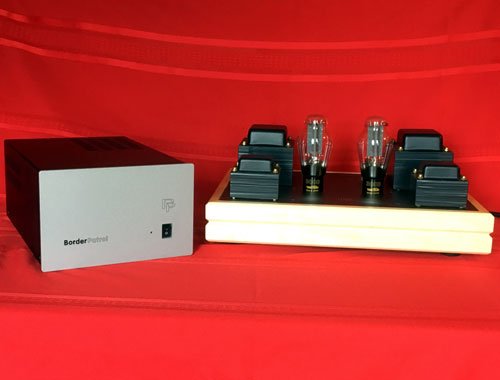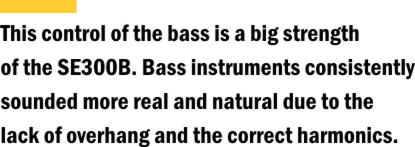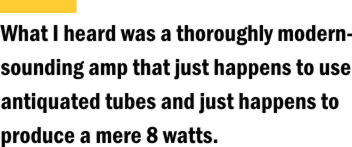BorderPatrol
• SE300B Stereo Amplifier
"You should hear this amp, especially if you think you know how a 300B-based amp sounds."
ou’re going to need to borrow our hand truck" were the words that came out of my friendly mail-carrier’s mouth as she swung open the side door to let me collect the BorderPatrol SE300B. My old body usually doesn’t appreciate a sentence like this, but BorderPatrol packs almost ten pounds per watt into their entry-level two-box SE300B, so I got pretty excited.
The main amplifier chassis has two output transformers as well as two interstage coupling transformers for the two driver tubes, along with two output tubes. Gary Dews of BorderPatrol has chosen 6C45pi driver tubes because it "has very high transconductance, low output impedance and exactly the right amount of gain to make it the perfect input/driver tube, provided it is used with an interstage transformer like in the SE300B." From the amp's name you've probably guessed that those 6C45pi tubes drive a pair of 300B tubes, providing 8 watts of power. The well-written owner's manual recommends 300B tubes from Electro Harmonix, EML (but not their mesh-plate tubes), Takatsuki and Western Electric. The review amp was shipped with the premium Takatsuki tubes. I was puzzled by the caution about mesh-plates because they're a favorite of mine. Dews' explanation was that he runs the 300B tube at a level that would be the maximum for a mesh-plate but well within the range of a solid-plate version. Reliability and tube life would be issues with mesh-plates in his amps, so he suggests sticking with solid-plates, and it's refreshing that his design allows the owner to get recommended performance with a such a wide range of power-tube options. Bias test points with their adjustment screws and hum pots are located on the bottom of the main amp. Because the review amp's tubes had been burned in before shipment, Dews advised that I wouldn't need to check them and owners need only check every three to six months of normal use. RCA inputs and speaker binding posts are on the top of the plinth, so I went with a more flexible cabling from BPT instead of my usual MIT choices, so I wouldn't put too much strain on the jacks. I placed the SE300B on the top of my rack, but if you choose to put your amp on a lower rack shelf, the top input and output terminals would be very convenient. I did try a few different power cords and settled on the Yamamoto cord that Shigeki-San supplies with his amps. Other brands could brighten up the sound just a bit, but I stayed with the Yamamoto for its better-integrated highs. The second part of this two-box amp is the hefty power supply connected to the main amp with a six-foot locking umbilical. A plain black metal box with an aluminum faceplate and about the size of an oversized loaf of artisan bread, the power supply weighs 33 pounds and contains three independent tube-rectified choke-input-filter supplies. The largest of these supplies the 300B tube and uses a GZ37/CV378 tube. The second uses an EZ80 tube and supplies the 6C45pi input stage, while another EZ80 supplies the bias voltage to the 300B. The choice of indirect-heated rectifiers is a bit unusual for mainstream tube amps, but Gary Dews responded that he had listened to many options and these rectifiers were chosen because of their great sound, slow warm-up times, ruggedness and bass response. In e-mails, the terms "ruggedness" and "long life" were mentioned many times -- BorderPatrol wants your purchase to sound good for a great many years. The front panel of the power supply has a small on/off switch with a thankfully small LED indicator. The back plate of the power supply has the necessary IEC power-cord receptacle, the aforementioned locking umbilical socket and a small toggle switch that can be used to isolate the amp in case you encounter hum. I didn't, so it stayed in the normal position. I should also mention the lack of hiss. If you decide that high-efficiency speakers and SET amps are for you, hum and hiss can haunt you. The SE300B was dead silent on both fronts, a great way to start an audition. ll of BorderPatrol's careful design work and the overbuilt power supplies would mean nothing if they didn't result in better sound. In the low-watt SET world, speaker matching is either an art or a struggle, depending on your perspective. I wanted to see how the SE300B would respond to my own BBC plan; go big (high efficiency) or go biamped, or get close (nearfield). I chose big first, in the form of a vintage pair of Altec Valencia speakers. This is a 50-year-old design with lots of friendly features for a low-watt amp; 97dB sensitivity, 16-ohm impedance and a big, beautiful 16" alnico woofer coupled to a horn-loaded 16-ohm alnico compression driver.
My wife recently attended a concert by Glen Velez and brought home his Breathing Rhythms CD [Sounds True MM00120D]. It is intended as a "meditation for energy and inner balance," but I didn't meditate much because the recording really energized the room. Track one, "Lunar Tides," uses close-miked riq and panderos, which are relatives to the tambourine and frame drum. You can certainly feel the air in the room vibrating from the percussion; then Velez's voice enters between the speakers, intoning the "Ta Ka Di Mi" rhythm cycle. I could almost feel his breath as he chanted. The words control and command kept coming back to me when listening with the SE300B. Well, those words along with fun. Fellow TAB reviewer Vance Hiner came over to hear the Valencia/BorderPatrol pairing, and I wish you could have seen his reaction to Wayne Hancock's Viper of Melody [Bloodshot #BS 163]: grinning ear to ear with both legs dancing and tapping as he sat on the couch, the clearest of example of what good audio equipment should bring into our lives. The SE300B put a smile on both of our faces. The only thing missing was that bit of extra character in the lower treble that some 300B-based amps have. That character has been described as an "inner light" from 300B tubes, and I'm perfectly happy that BorderPatrol has minimized it. Lesser amps strike me as too euphonic, too much of a good thing, and I feel that the SE300B is more accurate without losing too much of the glow we associate with the 300B tube. Additionally, the SE300B avoids any extra edge to give a false illusion of resolution. After enjoying this combination for a few weeks, it was time to move onto the second "B" of my plan: biamped. I moved the Valencias out and in came my Rethm Saadhanas. For all the wonderful things a stock version of the Valencias bring to a listening session, soundstaging and conveying minute details are not particular strengths. The Saadhanas are noted for their ability to throw a huge soundstage and are a comparably easy load for any amplifier. Mine are an earlier version using a Lowther DX55 in a back-loaded horn and assisted in the bass by an active subwoofer driving twin 6" woofers. Technically the Saadhanas are not fully biamped, because the Lowther is run full range and the active subwoofers are fed a high-level signal from the speaker terminals. Switching from a big cabinet with a 16" woofer to a pair of 6" woofers per side, I certainly lost the big bass of the Valencias, but in its place was a wall-to-wall soundstage in which the speakers completely disappeared. This was not the overblown type of soundstage with cymbals ricocheting off the side walls and triangles up at the ceiling. This was deep and precise. The soundstage was very slightly smaller than with my Yamamoto amps, but instrumental tone was so realistic that I immediately preferred the BorderPatrol amp's presentation, even if the size of the soundstage was ever so slightly reduced. A CD that I like to use to test soundstaging is The Lute Music of J.S. Bach Vol.2 by Eduardo EgŁez [MA Recordings MO54A]. It was recorded in a convent near Milan, Italy, and the reverb will swamp the lute tone with lesser electronics. The SE300B brought the lute into focus in the front of the stage and let the reverb trail off in a natural way. If you had asked me what was the SE300B's greatest asset based solely on the Valencias, I would have immediately said it was how forceful and quick the bass was, particularly considering that this is an 8-watt amplifier. After hearing it with the Rethms, I'm more inclined to say that the SE300B is one of those rare amps that immerses you in a soundstage that is very close to real, bringing you closer to the recording. At this year's CES, I heard exactly two systems that had this sort of holographic soundstaging, and both featured audio gear costing many, many multiples of the SE300B's price. Encouraged by the sound I was getting with the Saadhanas and SE300B, I decided to switch to vinyl to see if I could find another example of this holographic imaging. If you don't already own it, seek out Coleman Hawkins’ Desafinado [Impulse IMP-227]. A lovely collection of bossa nova and jazz sambas, the title track has the type of realism I’m describing. The clave has no real depth, sounds like a wood block being hit with a rubber mallet, and is projected too far forward. The guitars are better recorded and centered between the speakers. Then it happens! Hawk enters with the melody, and he's right there in the room. No, I don't mean a nice recording of Coleman Hawkins playing the tenor sax. Instead, this recording moves past all that and become the sound of Hawk playing for you in your living room. The better your system, the greater the effect will be, and the SE300B was pretty wonderful in placing the sax inside my living room. The imaging was so addictive that I began to search out recordings that featured instruments in real space and good studio recordings of voice and acoustic guitar. I cannot overstate that the SE300B does space in such a natural way that you will get to know your recordings better when it’s in your system. Finishing up with the close part of my BBC formula, I spent an afternoon with a small stand-mounted Mission speaker that unfortunately has no model number that I can see. This tiny speaker, with its 1" dome tweeter and 4" woofer, was a ridiculous match for the SE300B, costing one one-hundredth of its price, but I certainly enjoyed the ride. Johnny Adams' One Foot in the Blues LP [Rounder 2144] was rockin' the living room, and my nearfield seat (about four feet from the Missions) made volume concerns a non-issue. Adams' firmly centered singing was right in my face and Ed Peterson's tenor was blasting away above the right speaker. As a big-speaker fan, I couldn't live with this combination for long, but maybe you could if you have a quality Brit-box or something French or Italian of high quality. The SE300B's manual says the amp has been successfully paired with speakers as diverse as the Quad electrostatics and Snell Type As, so maybe the speaker you already own is a possible partner. I've not used the word treble once in my description of the SE300B's sound and that's a huge compliment to the design. At first listen you may think there is a lack of extension, but actually there is a smooth, grainless, and low-distortion high end that still manages to add lots of space to good recordings. Tweeters were better integrated into the overall sound of each speaker because of the SE300B's smooth, extended treble. Even the tweeterless Lowther DX55 in the Saadhanas benefited from the handling of the treble range. If you're familiar with that driver, you know this is not a minor point. How did the SE300B compare to my other SET amps? It's hard to imagine that the BorderPatrol SE300B and my Yamamoto A-09 ($4600 without tubes when still available) use the same output tubes. The A-09 pushes images out in front of the plane of the speakers, making for exciting soundscapes but with less total depth. Reverb trails are more prominent with the Yamamoto, due to its extra treble energy, but they don't last quite as long as they do with the BorderPatrol amp. Remember earlier in the review when I mentioned that some amps exploit the "inner light" of the 300B tube? The Yamamoto is member of that club, and for that reason both amps had strong personalities that were easily heard in comparative listening. One other big difference is the soft, rolling bass of my Yamamoto amp versus the authority and strength of the BorderPatrol. The power supply really does make a difference here. When I put my smaller Yamamoto A-08 ($2250 when still available) the tonal differences became slighter. Using 45 tubes instead of 300Bs, the baby Yamamoto only has about one real watt to work with but is very similar to the BorderPatrol in soundstage width and depth. Both of these amps have great midrange life, with the BorderPatrol edging the Yamamoto out in the bass and the utter realism that you can coax out of your best recordings. To be fair, neither of my Yamamoto amps is current, being a decade old, and cost about half or a third of the price of the SE300B. Are there some downsides to the SE300B? Sure. BorderPatrol makes more expensive amps for good reasons. The elephant in the room is that the SE300B has only 8 watts, and you have to match those watts to the appropriate speaker or you're wasting your time. BorderPatrol suggests speakers greater than 93dB efficient and staying above 6 ohms. If you need more power, BorderPatrol makes the S20 at 18 watts or the P20 at 20 watts, both using pairs of 300B tubes to achieve the higher rating. If you choose the SE300B, just heed the manual's guidelines and think of my BBC formula for success. Second, some visitors weren't thrilled with the simple aesthetic of the amp and power supply. While I can understand this, I found the understated looks pleasing and wouldn't trade any sound quality for a thick faceplate or overbuilt chassis. I do wish the amp's hum pots and bias adjustments were on top. Gary Dews says he'd have to completely redesign the amp to make this happen, and no customer has ever had a problem tipping the amp on its side to measure and adjust the bias. Because this is only necessary once every 3-6 months, invite a buddy over to help and treat him to some tunes after a quick check.
I initially thought the SE300B would be a nice,
nostalgic-sounding SET amp with lots of lush tone. What I heard was a thoroughly
modern-sounding amp that just happens to use antiquated tubes and just happens to produce
a mere 8 watts. You should hear this amp, especially if you think you know how a
300B-based amp sounds.
|



 After the
briefest of warm-up time just to make sure the amp had survived the trip, I fired up a
favorite CD of mine, Wood by Brian Bromberg [A440 Music 4001]. "The Saga of
Harrison Crabfeathers" showed the SE300B to be clear and forceful in the bass, and
this made Bromberg's string bass sound more like a real instrument in space rather than
just bass notes in the room. This control of the bass is a big strength of the SE300B.
Bass instruments consistently sounded more real and natural due to the lack of overhang
and the correct harmonics. And the energy and slam of the bass would fool many into
thinking there was a powerful solid-state amp driving the big Altecs. Drums and synth bass
were particularly fun and exciting on Daft Punk's "Lose Yourself to Dance" from
the Random Access Memories CD [
After the
briefest of warm-up time just to make sure the amp had survived the trip, I fired up a
favorite CD of mine, Wood by Brian Bromberg [A440 Music 4001]. "The Saga of
Harrison Crabfeathers" showed the SE300B to be clear and forceful in the bass, and
this made Bromberg's string bass sound more like a real instrument in space rather than
just bass notes in the room. This control of the bass is a big strength of the SE300B.
Bass instruments consistently sounded more real and natural due to the lack of overhang
and the correct harmonics. And the energy and slam of the bass would fool many into
thinking there was a powerful solid-state amp driving the big Altecs. Drums and synth bass
were particularly fun and exciting on Daft Punk's "Lose Yourself to Dance" from
the Random Access Memories CD [ he SE300B is
packed up for shipment back to BorderPatrol, and I'll miss it a lot. I was impressed with
its great bass coupled with soundstage definition that is so hard to achieve. During my
review the amp worked perfectly and gave the impression that it will last for many, many
years. The output tubes are expensive, but the rest of the tubes are moderately priced and
that counts for something when you're looking for a long-term amplifier relationship.
he SE300B is
packed up for shipment back to BorderPatrol, and I'll miss it a lot. I was impressed with
its great bass coupled with soundstage definition that is so hard to achieve. During my
review the amp worked perfectly and gave the impression that it will last for many, many
years. The output tubes are expensive, but the rest of the tubes are moderately priced and
that counts for something when you're looking for a long-term amplifier relationship.